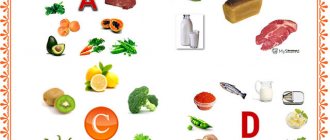Proper nutrition is the key to health and beauty
How to eat right - this question interests many, thanks to the popularization of a healthy lifestyle, an integral part of which is proper (healthy) nutrition. The basic principles of healthy eating should be laid down from childhood and must be adhered to throughout life. Unfortunately, currently in our country the number of people who are overweight and obese is growing. This problem is most relevant today in relation to children and youth, because Almost 300/0 of the population suffer from excess weight and obesity, half of them are under 18 years old. Just 15-20 years ago, obesity was rare among children aged five. Now this is a very common phenomenon.
The most common cause of the current situation is banal overeating due to established habits in the family. Quite often, parents overfeed their child, offering him portions that exceed age-appropriate portions, and also giving preference to the use of semi-finished products or fast food in the diet. A similar situation is quite often present in the nutrition of schoolchildren and students, who, refusing organized meals in school and student canteens, prefer chips, hot dogs, and sweet carbonated drinks. Quite often, children, like adults, “seize up” on problems related to studies, relationships in the family and the team. Every fourth child is overweight, every eighth is obese.
Let's dwell on the basic principles of proper (healthy) nutrition: 1. The daily diet should contain a sufficient amount of proteins, fats, carbohydrates, vitamins, and minerals. The amount of protein in the diet should correspond to the physiological norm - 1-1.5 g per 1 kg of weight. Animal protein should be at least 6094 of the daily amount of protein (the presence of lean meat, fish, eggs, milk and fermented milk products in the diet is mandatory). 2. The optimal amount of fat is 0.8-1.0 g per 1 kg of weight per day. Fats stay in the stomach longer, reduce the excitability of the brain, eliminating the feeling of hunger. Vegetable fats increase the activity of enzymes that stimulate the process of fat breakdown in the body. The diet should contain 30-3594 vegetable oils from the total amount of fat for cooking and adding to salads. Z. It is advisable to limit the amount of carbohydrates to 3-3.5 g per 1 kg of weight per day, primarily due to simple ones: sugar, sweets. 4. The number of meals during the day is at least 4-5 times (3 main meals and 2 additional meals, represented by fresh fruits and vegetables, preferably raw). The main caloric intake of the diet should occur in the first half of the day. 5. The intervals between meals should not exceed 3.5-4 hours. 6. The amount of free fluid is at least l.5J1 per day (in the absence of contraindications). It is best to drink and use bottled or home-filtered water for cooking. For drinking, you can use non-carbonated mineral water with the lowest degree of mineralization, freshly squeezed juices, tea, coffee. It is better not to drink coffee on an empty stomach; after 18 hours it is advisable not to drink green tea, hibiscus tea, coffee, or sour fruit juices. 7. In the morning on an empty stomach, it is advisable to drink a glass of liquid at room temperature. The interval between the last intake of liquid and food should be 20-30 minutes, between food and the next intake of liquid at least 30 minutes. The optimal ratio between solid and liquid parts of food during one meal should be at least 2:1. 8. Last meal - 2.5-3 hours before bedtime. 9. Eat slowly, chew your food thoroughly, get up from the table as soon as you feel full, and not when you are ready to burst. 10. Try to avoid combinations in one dish: protein foods (meat, poultry, fish, seafood) and foods rich in carbohydrates (cereals, bread, bran, potatoes, sweet fruits and berries). 11. Limit salt intake to 5g. per day. 12. Food should be as varied as possible. The human gastrointestinal tract contains a sufficient number of enzymes that can break down various products. 13. Avoid multi-ingredient dishes. Do not mix more than 3-4 types of products at one time (not counting spices and vegetable oil). 14. Vegetables containing pectin and fiber are especially useful. They create a feeling of fullness, regulate intestinal function, and remove toxins. These include cabbage, zucchini, radishes, tomatoes, cucumbers, pumpkin, and leafy greens. 15. Vegetables can be eaten raw, stewed, boiled, steamed and grilled. It is preferable to consume fresh vegetables with vegetable oil (sunflower, olive, flaxseed). When cooking vegetables, the water should not completely cover their surface. It is better to add salt, vegetable oil and natural spices at the final stage of cooking. 16. Meat, poultry, and fish can be baked, steamed, or grilled. It is better to consume these products with a vegetable side dish. It is advisable not to eat the skins of poultry and fish. 17. Methods of preparing food (in descending order of quality): grill (air grill, grill in a microwave oven, barbecue, barbecue); steaming food; baked in the oven; salty; dried; boiled; stewed 18. Bread must be present in the diet, preferably grain, with bran, protein. 19. Sauces are better than homemade ones with vegetables, natural spices: bay leaf, peppercorns, parsley, cilantro, celery, cloves, cumin, garlic, dill, cloves, ginger. Proper nutrition is the key not only to health, but also to natural beauty: clear skin, toned, slender body, shiny hair, natural blush. By eating right, you will maintain health and beauty. Chief freelance nutritionist of the Ministry of Health M.V. Popova
Seal
Quiz "Proper nutrition"
Quiz "Proper nutrition"
Goal: updating and developing students’ knowledge about proper nutrition as one of the components of a healthy lifestyle.
A “healthy lifestyle” includes several components. And one of them is very important - healthy eating. But is all the food we eat equally healthy? What foods should you choose to maintain your health for many years?
We invite you to take part in a quiz called “Proper Nutrition”, which will show the best experts in this field.
The team that completes the tasks most creatively wins.
All answers to assignments must be submitted electronically.
Station 1 – “Colorful tables”
Task: Distribute products into baskets:
- Green basket. Foods you need to eat regularly.
- Yellow basket. Foods that should be eaten irregularly.
- Red basket. Foods you shouldn't eat.
Group 1: wheat and rye bread, vegetables, fruits, buns, cereals, cakes, chips;
Group 2: berries, sugar, milk, sweets, pickled foods, pizza, sweet carbonated drinks.
Group 3: meat, cheese, honey, eggs, fish, butter.
Station 2 – “Healthy eating”
Assignment: Name the product.
- This product is considered originally Russian. It was from the Russians that they learned about him in Europe. For a long time it was called “Russian cream”. Its name comes from the word “sweep”, reflecting the method of its preparation.
- This is one of the main products in human nutrition. It serves as a source of protein; both first and second courses are prepared from it. It is recommended to eat it in combination with vegetable side dishes. It is believed that in this case it is better absorbed.
- According to the Russian proverb, if you eat this product, you will have “nimble legs.” This is due to the fact that this product is a source of phosphorus, necessary for the formation of bone tissue, so dishes prepared from it are especially useful for children's growing bodies.
- This product was considered sacred by the ancient Egyptians. And medieval knights wore it under their armor, as it was believed that it protected against the enemy. In fact, this product has antibacterial properties and is able to destroy microorganisms, contains vitamin C and a number of other important vitamins.
- This root vegetable can be white, purple, yellow, red. However, the most familiar color for us is orange. This variety of root vegetable was developed in the 18th century. In honor of the Dutch queen, since orange was the symbol of the royal house. The root vegetable contains a large amount of vitamin A, which helps preserve vision.
- It can be green, red, yellow, white and black. Its use in many countries has turned into a real ritual. In Uzbekistan and Kazakhstan they mainly use green, in Japan – green and white, in Russia – black. It helps to invigorate, cools in hot weather, warms in cold weather.
Station 3 – “Role for the body”
Assignment: List examples of products in each area.
"Products that: "
- Improves brain activity: …….
- Helps digestion: ....
- Strengthens bones: ……
- They are a source of vitamins: .....
- Gives strength, builds muscle mass: ....
- For energy and vigor: ....
Station 4 – “Proper nutrition”
A person cannot live for long without food; food is necessary for a person throughout his life. But not all the foods we eat are beneficial for our body. What should you eat to stay healthy? What is useful for us?
Task: Decipher the names of fruits, vegetables and berries. You need to find as many berries, fruits and vegetables as possible.
Station 5 – “Creative”
Assignment: Compose a syncwine on the topic “Nutrition”.
A cinquain is a poem written according to the following rules:
Line 1 – one noun expressing the main theme of the syncwine.
Line 2 – two adjectives expressing the main idea.
Line 3 – three verbs describing actions within the topic.
Line 4 is a phrase that carries a certain meaning.
Line 5 – conclusion in the form of a noun (association with the first word).
Station 6 – “Healthy eating”
Assignment: Make recommendations for healthy eating (at least 10 points).
We talked about one part of a healthy lifestyle - proper nutrition.
We wish you to bloom and grow
Save money, improve your HEALTH,
It is for a long journey -
The most important condition.






